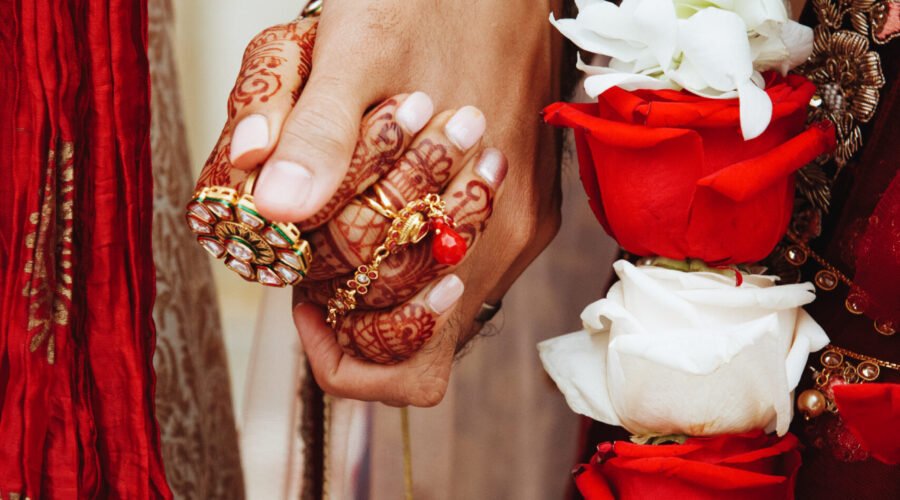Hindu Wedding Ceremony | Vedic Hindu Wedding Order
Hindu Vedic Marriage Ritual
Hindu tradition holds that of the four stages of life, marriage is the most significant. It is considered to be a link between two families as well as the joining of two souls. Fundamentally, a Hindu marriage ceremony connects the spiritual, mental, and physical aspects of two separate souls. The marriage ceremony is performed in accordance with Vedic customs, and matrimony is a holy connection. The Vedas, the most revered texts in Hinduism, are the source of the Vedic rites. Hindu culture places great value on the rituals, despite the fact that they have been greatly simplified in modern times. Every action in the ceremony has a purpose that is both life-affirming and has deep spiritual significance. The world’s oldest language, Sanskrit, will be used for the ritual, which the priest will translate into English. The meaning of the rites will be explained in the brief descriptions of each section of the ceremony that follow.
Swagat of Baarat
The Groom’s Arrival: Dancing in celebration of his wedding, the groom arrives with his family and friends. The bride’s family formally welcomes the groom, his family, and friends upon the joyous arrival of the baraat. The bride’s mother feeds the groom nicely, gives him Arati (ceremonial worship), and puts tilak (red vermilion powder) on his forehead. After that, the groom is taken to the wedding altar, or mandap, where the marriage ritual takes place.
Milni
In order to signify the coming together of two families and the start of new friendships, the bride and groom’s families hug and drape a garland on one another.
Kanya Aagman: The bride arrives
The bride is brought to the Mandap by her maternal uncles. Chanted lyrics, known as Manglashtak, accompany the bride’s entry into the mandap.
Salutations, Malas. Declaring that she has freely chosen the groom, the bride offers the first garlands. The groom will then repay the favor by presenting her with a garland, wishing her a happy new life, and assuring her that he will take care of her.
Lord Ganesh is worshipped during Ganesh Pooja.
Praying to Lord Ganesh for peace and harmony to rule during the event is the first part of the wedding ritual. For the couple’s fortunate start, Lord Ganesh’s blessings are requested.
Kanyadan: Handing over the bride’s
The bride’s parents perform this rite, putting their daughter down for marriage by laying her right hand on the groom’s right hand as the priest chants the words. The parents of the bride hope their son-in-law will take good care of their daughter.
Granthibandan
While the bride is wearing her saree, the groom ties his scarf or shawl around her shoulders and chants prayers to Lord Ganesh, Goddess Umaa, Lord Narayan, and Laxmi Devi, asking for a marriage as strong as theirs. The knot represents the joining of two souls in holy matrimony.
Havan
By starting a small, holy fire in the center of the Mandap, Agni, the Fire God, is called to serve as the main witness to the union. The couple honors Agni, the goddess of force, light, and purity, by placing rice, flowers, and ghee—purified butter—into the flame. Since Agni is the one who leads us toward eternal light and truth and banishes ignorance and darkness from our life, these prayers are extremely important.
Steps around the Holy Fire at Mangal Fera
The priest repeats mantras as the couple walks around the holy fire. Every time, they pause to allow the bride and groom to touch a stone, which represents the depth of their love and loyalty to one another. Every phera (circle) ends with the bride’s brother filling her open palms with grains, a symbol of prosperity and fortune. As a playful custom, the couple will dash to take a seat first after the final fera. The first person to sit will supposedly be the head of the household.
The Seven Steps of Saptapadi
The couple takes seven steps at this crucial point in the ceremony to represent the start of their life together. At the start of each step, the priest and everyone else in attendance bless the couple as they accept a vow. The bride and groom ask for each other’s help in these vows to ensure a happy and prosperous marriage.
Sindur
As a sign of a married lady, the bride’s forehead and hair parting are marked with sindhoor, or scarlet vermillion powder, by the groom.
Dharan Mangal Sutra
The English wedding ring is replaced with a golden necklace with black beads that the husband wraps around the bride’s neck as a symbol of his love, loyalty, and regard for her. The love and holy union of the couple are likewise symbolized by the Mangal Sutra.
Kansar: Providing dessert
A couple exchanges candies during kansar as a sign of their commitment to one another and as a pledge to take care of one another’s needs at home.
Aashirwad: Salutations
By reciting a few Vedic mantras, the priest bestows blessings onto the bride and groom. After getting married, the newlyweds ask the priest, their parents, friends, and relatives for blessings so they can have a happy married life.
Vidai / Doli Departure
The bride is said goodbye by her relatives as the couple leaves. As the bride departs her parent’s house to start a new life with her husband and his family, her family bids her farewell in a heartfelt, tearful, and joyous way.



